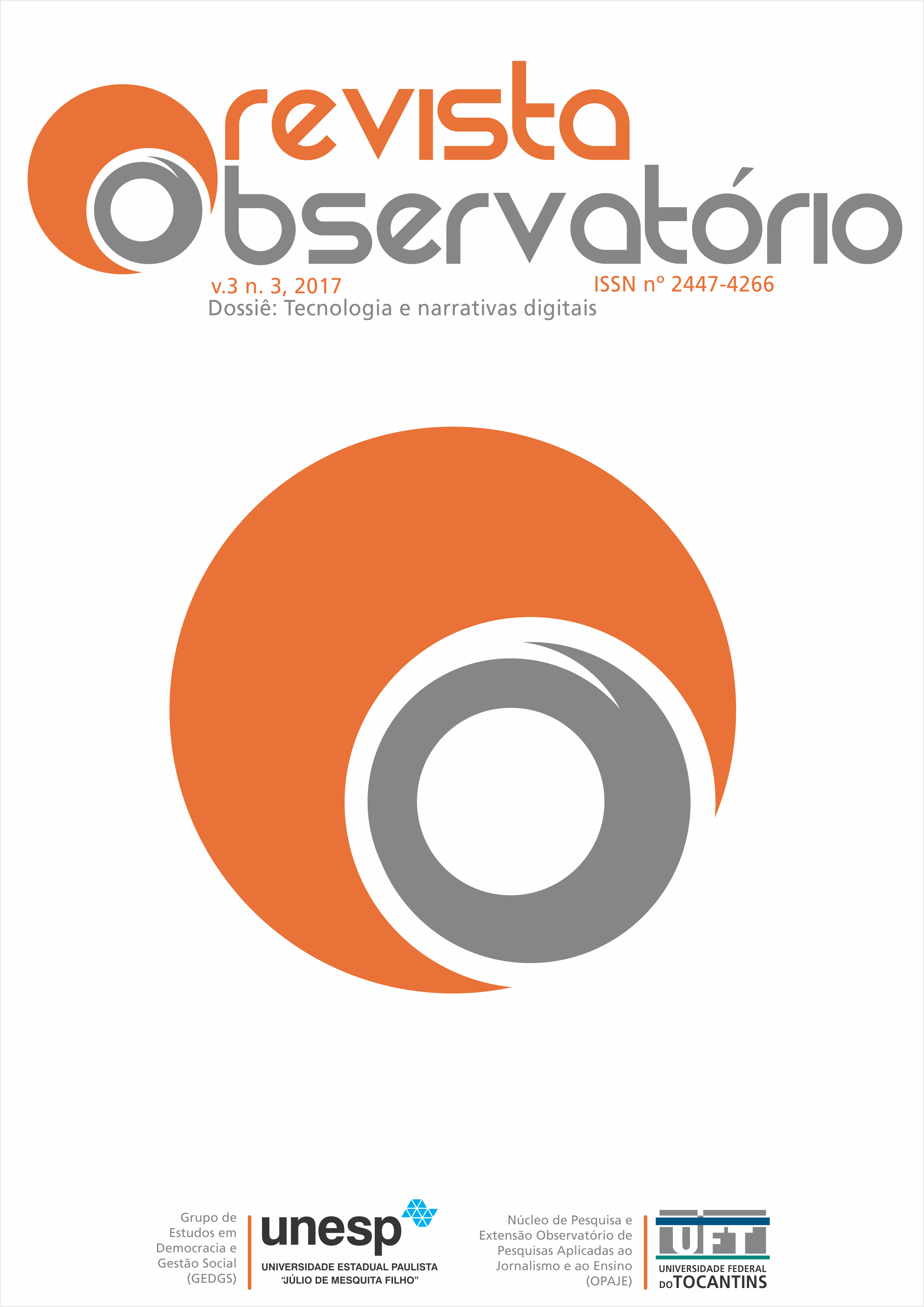AUTOMATED JOURNALISM, NATURAL LANGUAGE GENERATION AND THE LOGIC OF GOOD ENOUGH
DOI:
https://doi.org/10.20873/uft.2447-4266.2017v3n3p60Keywords:
automated journalism, robots and journalism, jornalism algorithm, future of jornalismAbstract
The explosion of digital data and the advance of the field of Artificial Intelligence allowed the emergence of algorithms capable of automatically writing and distributing news stories quickly and in a customized way. The automation of narrative production delivers basic, objective and unsophisticated texts, shaping the role of journalists and contributes to the expansion of the so-called "filter bubble" defined by Eli Pariser. In this text, we try to demonstrate that in adopting automation, essays in the United States, Europe and China have come to use the logic of good enough, demonstrated by Robert Capps. That is to say, the automation of the elaboration of news can be adopted solely by its "industrial" character and by the radically reduced cost, not prioritizing the diversification, the culture and the human quality of the stories. The reflections center on bibliographic research of an exploratory and interdisciplinary character, based on the approach of the Theory-Actor Network.
Downloads
References
ANDERSON, C. W; MAYER, Juliette. Objects of journalism and the news. Journalism, 16 v., 2015.
ARCE, Tacyana. O lead automatizado: uma possibilidade de tratamento da informação para o jornalismo impresso diário. Revista Exacta, Belo Horizonte, v.2, n. 3, 2009.
BRYNJOLFSSON, Erik; MCAFEE, Andrew. A segunda era das máquinas: trabalho, progresso e prosperidade em uma época de tecnologias brilhantes. Rio de Janeiro: Alta Books, 2015.
BUNGE, Mario. Dicionário de filosofia. Tradução de Gita K. Guinsburg. 1. reimp. São Paulo: Perspectiva, 2012.
CARLSON, Matt. The robotic reporter: automated journalism and the redefinicion of labor, compositional forms and journalistic authority. In: LEWIS, Seth C. (Org.). Digital Journalism. v.3, n.3. New York: Taylor&Francis Online, 2016.
CAPPS, Robert. The good enough revolution: when cheap and simple is just fine. Wired, 24 ago. 2009. Disponível: <https://www.wired.com/2009/08/ff-goodenough/> Acesso: 10 ago. 2016.
DALEN, Arjen van. The Algorithms Behind the Headlines: How machine-written news redefines the core skills of human journalists. Journalism Practice. Volume 6, Issue 5-6. New York: Routledge, 2012.
DAVENPORT, Thomas H. Ecologia da informação: por que só a tecnologia não basta para o sucesso na era da informação. São Paulo, Futura, 1998. Disponível em: <http://amormino.com.br/livros/20141114-ecologia-informacao.pdf>. Acesso em: 10 de ago. 2015.
DIAKOPOULOS, Nicholas. Algorithmic accountability reporting: on the investigation of black boxes. Town Center for Digital Journalism. 2013. Disponível em: < http://towcenter.org/wp-content/uploads/2014/02/78524_Tow-Center-Report-WEB-1.pdf>. Acesso: 10 abr. 2016.
DÖRR, Konstantin Nicholas. Mapping the field of algorithmic journalism. 2015. Disponível em: <http://www.tandfonline.com/doi/full/10.1080/21670811.2015.1096748>. Acesso: 24 set.2016.
FLORIDI, Luciano. The language of information. In: ________________ Information: a very short introduction. New York: Oxford University Press, 2000. p. 19-36.
GRAEFE, Andreas. Guide to automated journalism. Town Center for Digital Journalism. Jan. 2016. Disponível em: < http://towcenter.org/research/guide-to-automated-journalism/ > Acesso em 08 abr. 2016.
GUDWIN, Ricardo. Geração de linguagem natural. mensagem pessoal. Mensagem recebida por em 31 jan.2017.
KAKU, Michio. A física do futuro: como a ciência moldará o mundo nos próximos cem anos. Tradução de Maria Carvalho e João C. S. Duarte. Lisboa: Editorial Bizâncio, 2011.
KURZWEIL. A era das máquinas espirituais. Tradução de Fábio Fernandes. 2.reimp. São Paulo: Aleph, 2007.
LATAR, Noam. The Robot Journalism in the Age of Social Physics: the end of human journalism? The New World of Transitioned Media. Springer, 2015.
LATOUR. Bruno. Reagregando o social: uma introdução à teoria Ator-Rede. Tradução de Gilson César Cardoso de Sousa. Salvador: Edufba, 2012.
LECOMPTE, Celeste. Automation in the Newsroom. Nieman Foundation, 1o. set. 2015. Disponível em: < http://niemanreports.org/articles/automation-in-the-newsroom >. Acesso em: 02 mar. 2016.
LINDEN, Car-Gustav. Decades of automation in the newsroom: why are there still so many jobs in journalism? Mar. 2016.
HAMMOND, Kristian. The value of big data insn’t the data. Harvard Business Review, mai. 2013. Disponível em: < https://hbr.org/2013/05/the-value-of-big-data-isnt-the>. Acesso: 22 fev.2016.
__________________. Practical artificial intelligence for dummies. 2015. Disponível em: <http://gunkelweb.com/coms493/texts/AI_Dummies.pdf>. Acesso: 28 mai. 2016.
MAYER-SCHÖNBERGER, Viktor; CUKIER, Kenneth (2013). Big Data: a revolution that will transform how we live, work and think. London: John Murray, 2013.
MITCHELL, Melanie. Complexity: a guide tour. New York: Oxford University Press, 2009.
NILSSON, Nils J. The quest of artificial intelligence: a history of ideas and achievements. Standard University. 2010.
NORMANDE, Naara. A automatização da narrativa jornalística. Estudos em Comunicação, n.13, 2013, p.363-378. Disponível em: <http://www.ec.ubi.pt/ec/13/pdf/EC13-2013Junho-14.pdf>. Acesso: 10 abr. 2016.
OSBORNE, Michael A.; FREY, Carl Benedikt. The future of employment: how susceptible are jobs to computarisation? Oxford University, sep. 17, 2013.
PARASIE, Sylvain; DAGIRAL, Eric. Data-driven journalism and the public good: “computer-assisted-reporters'' and ''programmer-journalists'' in Chicago. New Media & Society. 2012. Disponível em: <http://www.blogg.sh.se/datajournalistik/wp-content/uploads/2013/02/New-Media-Society-2012-Parasie-1461444812463345.pdf>. Acesso: 17 set. 2016.
PARISER, Eli. O filtro invisível: o que a internet está escondendo de você. Tradução de Diego Alfaro. Rio de Janeiro: Zahar, 2012.
PINTO, Álvaro Vieira. O conceito de tecnologia. 1v, 2 reimp. Rio de Janeiro: Contraponto, 2013.
PRIMO, Alex; ZAGO, Gabriela. Who and what do journalism? An actor-network perspective. Digital Journalism, 2014. Vol. 3, no. 1, p. 38-52.
SANTOS, Márcio Carneiro dos. __________________________. Comunicação digital e jornalismo de inserção: como big data, inteligência artificial, realidade aumentada e internet das coisas estão mudando a produção de conteúdo informativo. São Luis: Labcom Digital, 2016a.
__________________________Automated narratives and journalistic text generation: the lead organization structure translated into code. Brazilian Journalism Research: Revista da Associação Brasileira de Pesquisadores em Jornalismo (SBPJor), Brasília, v.12, n.1, 2016b. P. 150-175. Disponível em: < https://bjr.sbpjor.org.br/bjr/article/view/921>. Acesso: 30 jun.2016.
SAURWEIN, Florian; JUST, Natascha; LATZER, Michael. 2015. Governance of algorithms: options and limitations. Set. 2015. Disponível em:< http://www.mediachange.ch/media/pdf/publications/GovernanceOfAlgorithms.pdf>. Acesso: 2 ago. 2016.
WHITBY, Blay. Inteligência Artificial: um guia para iniciantes. Tradução: Claudio Blanc. São Paulo: Madras, 2004.
Downloads
Published
How to Cite
Issue
Section
License
[PT] Autores que publicam nesta revista concordam com os seguintes termos:
1. Autores mantém os direitos autorais e concedem à revista, sem pagamento, o direito de primeira publicação, com o trabalho simultaneamente licenciado sob a Creative Commons Attribution License (CC BY-NC 4.0), permitindo o compartilhamento do trabalho com reconhecimento da autoria do trabalho e publicação inicial nesta revista.
Leia todos os termos dos direitos autorais aqui.

